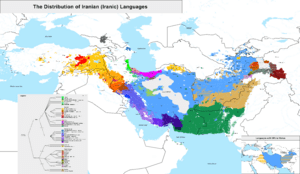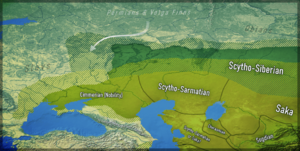Eastern Iranian languages facts for kids
Quick facts for kids Eastern Iranian |
|
|---|---|
| Geographic distribution: |
Central Asia, South Asia, Caucasus |
| Linguistic classification: | Indo-European
|
| Subdivisions: |
Northeastern
Southeastern
|

The Eastern Iranian languages are a group of languages that belong to the larger Iranian languages family. They started to develop a long time ago, around 400 BC to 900 AD. One very old language, Avestan, is often thought to be an early Eastern Iranian language.
The biggest Eastern Iranian language spoken today is Pashto. It has at least 80 million speakers! Most Pashto speakers live in Afghanistan and Pakistan. The second largest is Ossetic, with about 600,000 speakers in a region called Ossetia, which is in Georgia and Russia. All the other Eastern Iranian languages have fewer than 200,000 speakers combined.
Most of these languages are spoken in a connected area. This includes southern and eastern Afghanistan, parts of western Pakistan, a mountainous region in eastern Tajikistan, and western China. However, two languages are spoken far away from this main area:
- The Yaghnobi language is spoken in northwestern Tajikistan. It comes from an older language called Sogdian.
- The Ossetic language is spoken in the Caucasus mountains. It comes from the ancient Scytho-Sarmatian languages.
These languages are like living reminders of a huge language family that once spread across much of Central Asia, parts of the Caucasus, and even into Eastern Europe thousands of years ago. This large area was once known as Scythia.
Contents
History of Eastern Iranian Languages
Western Iranian languages likely separated from an even older language called Proto-Iranian around 2000 BC. Eastern Iranian languages then developed from Proto-Iranian in a different region.
Because the Greeks were present in Central Asia a long time ago, some of the Eastern Iranian languages were written down during their "Middle Iranian" stage. This helps us understand how they developed. Sadly, we have very few records of the Scytho-Sarmatian languages that stretched across a huge area from Kazakhstan to Ukraine. Some people believe that Eastern Iranian cultures even influenced Russian folk traditions.
Later, after Arab armies arrived and Islam spread, the Middle Persian language (which became Dari) became very popular around the Oxus River, Afghanistan, and a region called Khorasan. The way Persian was written also changed, using the Arabic alphabet instead of an older one.
This spread of Persian Dari led to some Eastern Iranian languages, like Bactrian and Khorezmian, disappearing over time. Today, only a few speakers of Yaghnobi remain. This happened because many Persian-speaking people were part of the armies and governments that came into Central Asia.
How Eastern Iranian Languages Are Grouped
Eastern Iranian languages are like a big family where many dialects are very similar and have changed in similar ways. So, instead of strict "branches," it's often better to think of them as language "areas."
Here's a simplified look at how these languages are classified by time period:
Old Iranian Period
These are very old languages, spoken thousands of years ago.
- Northeast: Scythian, Old Saka, and others (now extinct).
- Avestan (around 1000 BC to 7th century BC). Avestan is sometimes grouped with Eastern Iranian, but it's unique.
Middle Iranian Period
These languages were spoken between about 400 BC and 900 AD. Many of them are now extinct.
- Bactrian (around 4th century BC – 9th century AD)
- Khwarezmian (around 4th century BC – 13th century AD)
- Sogdian (from around 4th century AD)
- Scytho-Khotanese (Saka) (around 5th century – 10th century AD) and Tumshuqese (7th century AD)
- Scytho-Sarmatian (from around 8th century BC)
Modern Eastern Iranian Languages
These are the languages still spoken today.
- Pashto (with different ways of speaking it, called dialects)
- Wanetsi
- Pamir languages (a group of languages spoken in the Pamir Mountains)
- North Pamir: Yazgulami, Shughni (with its own dialects like Oroshori, Roshani, Khufi, Bartangi), and Sarikoli.
- Sanglechi-Ishkashimi: Sanglechi and Ishkashimi.
- Wakhi
- Munji-Yidgha: Munji and Yidgha.
- Ormuri-Parachi: Ormuri and Parachi.
- Northern: Yaghnobi and Ossetian (with dialects like Iron, Digor, and the extinct Jassic).
Language Characteristics
Eastern Iranian languages have gone through many interesting sound changes over time. For example, a "ch" sound might have changed to a "ts" sound in some of them.
Here's a table showing how some words sound in different Eastern Iranian languages:
| English | Avestan | Pashto | Munji | Sanglechi | Wakhi | Shughni | Parachi | Ormuri | Yaghnobi | Ossetic |
|---|---|---|---|---|---|---|---|---|---|---|
| one | aēva- | yaw | yu | vak | yi | yiw | žu | sō | ī | iu |
| four | t͡ʃaθwārō | tsalṓr | t͡ʃfūr | tsəfúr | tsībɨr | tsavṓr | t͡ʃōr | tsār | (tafṓr)1 | cyppar |
| seven | hapta | ōwə | ōvda | ōvδ | ɨb | ūvd | hōt | wō | aft | avd |
- In Yaghnobi, the first part of the word for "four" was lost because of how the word was stressed.
Sound Changes in Eastern Iranian Languages
A common change in most Eastern Iranian languages is how certain "stop" sounds (like 'b', 'd', 'g') became softer, more like "fricative" sounds (like 'v', 'th', 'gh'). This often happened at the beginning of words. For example, an old 'b' sound might have become a 'v' sound.
Here's another table showing how these sounds changed:
| English | Avestan | Pashto | Munji | Sanglechi | Wakhi | Shughni | Parachi | Ormuri | Yaghnobi | Ossetic |
|---|---|---|---|---|---|---|---|---|---|---|
| ten | dasa | las | los / dā | dos | δas | δis | dōs | das | das | dæs |
| cow | gav- | ɣwā | ɣṓw | uɣūi | ɣīw | žōw | gū | gioe | ɣōw | qug |
| brother | brātar- | wrōr | vəróy | vrūδ | vīrīt | virṓd | byā | (marzā) | virṓt | ærvad |
Outside Influences
Languages often borrow from each other! The Eastern Iranian languages have been influenced a lot by neighboring Indo-Aryan languages. This can be seen in how they pronounce certain sounds, like "retroflex consonants" (sounds made with the tongue curled back) and "aspirated consonants" (sounds made with a puff of air). For example, you can hear these influences in Pashto and Wakhi.
See also
- Western Iranian languages
- Dari (Eastern Persian), a dialect of a Western Iranian language, even though its name sounds similar to "Eastern"
- Sakan language


